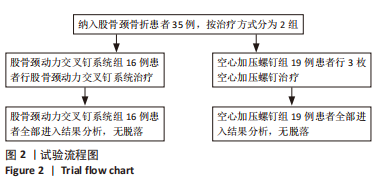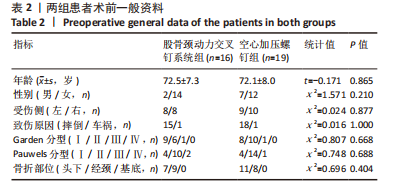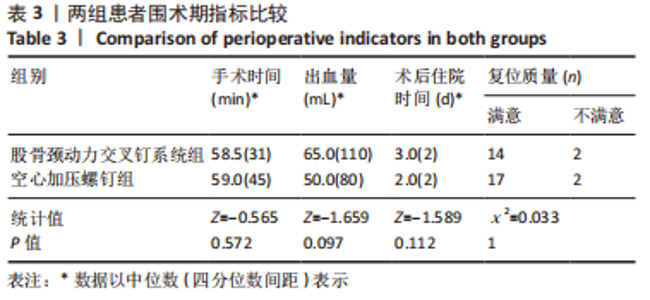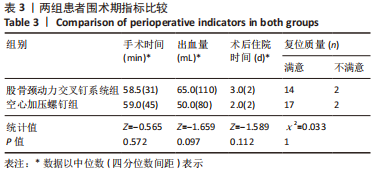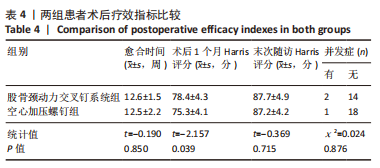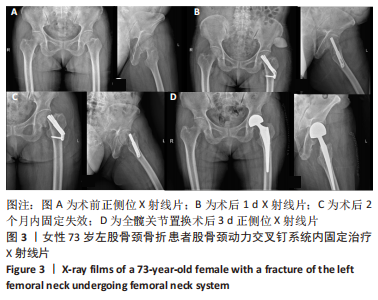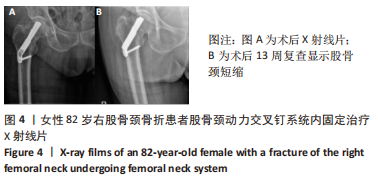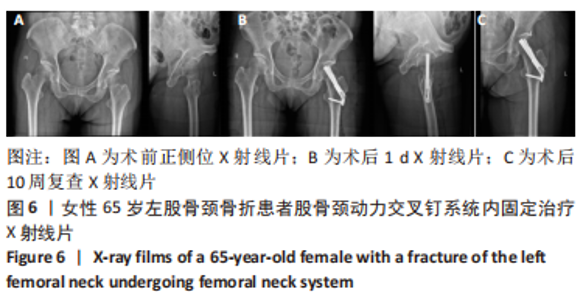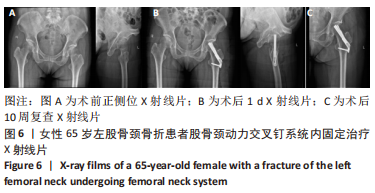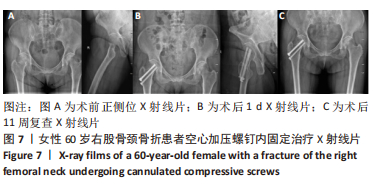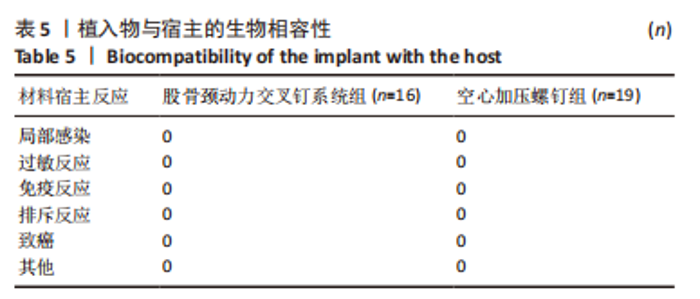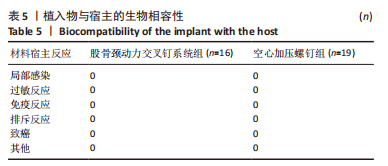Chinese Journal of Tissue Engineering Research ›› 2023, Vol. 27 ›› Issue (36): 5828-5833.doi: 10.12307/2023.730
Previous Articles Next Articles
Comparison of short-term follow-up results between femoral neck system and cannulated compressive screws in the treatment of femoral neck fracture in the elderly
Wang Tianhao, Liang Xiaolong, Zheng Kai, Li Rongqun, Zhou Jun, Geng Dechun, Xu Yaozeng, Zhu Feng
- Department of Orthopedics, First Affiliated Hospital of Soochow University, Suzhou 215008, Jiangsu Province, China
-
Received:2022-09-09Accepted:2022-11-16Online:2023-12-28Published:2023-03-25 -
Contact:Zhu Feng, Master, Attending physician, Department of Orthopedics, First Affiliated Hospital of Soochow University, Suzhou 215008, Jiangsu Province, China -
About author:Wang Tianhao, Master candidate, Department of Orthopedics, First Affiliated Hospital of Soochow University, Suzhou 215008, Jiangsu Province, China
CLC Number:
Cite this article
Wang Tianhao, Liang Xiaolong, Zheng Kai, Li Rongqun, Zhou Jun, Geng Dechun, Xu Yaozeng, Zhu Feng. Comparison of short-term follow-up results between femoral neck system and cannulated compressive screws in the treatment of femoral neck fracture in the elderly[J]. Chinese Journal of Tissue Engineering Research, 2023, 27(36): 5828-5833.
share this article
Add to citation manager EndNote|Reference Manager|ProCite|BibTeX|RefWorks
| [1] MILLER BJ, CALLAGHAN JJ, CRAM P, et al. Changing trends in the treatment of femoral neck fractures: a review of the american board of orthopaedic surgery database. J Bone Joint Surg Am. 2014;96(17): e149. [2] ROBERTS KC, BROX WT, JEVSEVAR DS, et al. Management of hip fractures in the elderly. J Am Acad Orthop Surg. 2015;23(2):131-137. [3] ZUCKERMAN JD. Hip fracture. N Engl J Med. 1996;334(23):1519-1525. [4] 吴新宝, 杨明辉. 老年髋部骨折诊疗专家共识(2017)[J]. 中华创伤骨科杂志,2017,19(11):921-927. [5] RAMADANOV N, TOMA I, HERKNER H, et al. Factors that influence the complications and outcomes of femoral neck fractures treated by cannulated screw fixation. Sci Rep. 2020;10(1):758. [6] SLOBOGEAN GP, SPRAGUE SA, SCOTT T, et al. Complications following young femoral neck fractures. Injury. 2015;46(3):484-491. [7] TANG Y, ZHANG Z, WANG L, et al. Femoral neck system versus inverted cannulated cancellous screw for the treatment of femoral neck fractures in adults: a preliminary comparative study. J Orthop Surg Res. 2021;16(1):504. [8] STOFFEL K, ZDERIC I, GRAS F, et al. Biomechanical Evaluation of the Femoral Neck System in Unstable Pauwels III Femoral Neck Fractures: A Comparison with the Dynamic Hip Screw and Cannulated Screws. J Orthop Trauma. 2017;31(3):131-137. [9] RS G. Low-angle fixation in fractures of the femoral neck. J Bone Joint Surg Br. 1961;43:647-663. [10] NANTY L, CANOVAS F, RODRIGUEZ T, et al. Femoral neck shortening after internal fixation of Garden I fractures increases the risk of femoral head collapse. Orthop Traumatol Surg Res. 2019;105(5):999-1004. [11] AUGAT P, BLIVEN E, HACKL S. Biomechanics of Femoral Neck Fractures and Implications for Fixation. J Orthop Trauma. 2019;33 Suppl 1: S27-S32. [12] WEN A, CHONG BYK, JOSEPH LV, et al. Challenges in osteoporosis treatment initiation in geriatric patients admitted under the hip-fracture pathway. Arch Osteoporos. 2022;17(1):136. [13] LEBOFF MS, GREENSPAN SL, INSOGNA KL, et al. The clinician’s guide to prevention and treatment of osteoporosis. Osteoporos Int. 2022; 33(10):2049-2102. [14] LORENTZON M. Treating osteoporosis to prevent fractures: current concepts and future developments. J Intern Med. 2019;285(4):381-394. [15] HOAGLUND FT, LOW WD. Anatomy of the femoral neck and head, with comparative data from Caucasians and Hong Kong Chinese. Clin Orthop Relat Res. 1980;152:10-16. [16] ZHAO G, LIU C, CHEN K, et al. Nonanatomical Reduction of Femoral Neck Fractures in Young Patients (</=65 Years Old) with Internal Fixation Using Three Parallel Cannulated Screws. Biomed Res Int. 2021; 2021:3069129. [17] PANTELI M, RODHAM P, GIANNOUDIS PV. Biomechanical rationale for implant choices in femoral neck fracture fixation in the non-elderly. Injury. 2015;46(3):445-452. [18] DAVIDOVITCH RI, JORDAN CJ, EGOL KA, et al. Challenges in the treatment of femoral neck fractures in the nonelderly adult. J Trauma. 2010;68(1):236-242. [19] FAN Z, HUANG Y, SU H, et al. How to choose the suitable FNS specification in young patients with femoral neck fracture: A finite element analysis. Injury. 2021;52(8):2116-2125. [20] ZHOU XQ, LI ZQ, XU RJ, et al. Comparison of Early Clinical Results for Femoral Neck System and Cannulated Screws in the Treatment of Unstable Femoral Neck Fractures. Orthop Surg. 2021;13(6):1802-1809. [21] PING H, LING X, XUE Y, et al. Effect of ERAS Combined with Comfortable Nursing on Quality of Life and Complications in Femoral Neck Fractures of the Aged People. Evid Based Complement Alternat Med. 2021; 2021:8753076. [22] KUBIAK EN, BEEBE MJ, NORTH K, et al. Early weight bearing after lower extremity fractures in adults. J Am Acad Orthop Surg. 2013;21(12): 727-738. [23] DONOHOE E, ROBERTS HJ, MICLAU T, et al. Management of Lower Extremity Fractures in the Elderly: A Focus on Post-Operative Rehabilitation. Injury. 2020;51 Suppl 2:S118-S122. [24] KURU T, OLCAR HA. Effects of early mobilization and weight bearing on postoperative walking ability and pain in geriatric patients operated due to hip fracture: a retrospective analysis. Turk J Med Sci. 2020;50(1): 117-125. [25] ATZMON R, DREXLER M, OHANA N, et al. The effect of postoperative weight-bearing status on mortality rate following proximal femoral fractures surgery. Arch Orthop Trauma Surg. 2022;142(6):947-953. [26] 严才平, 王星宽, 向超, 等. 股骨颈动力交叉钉系统与空心加压螺钉治疗中青年股骨颈骨折的疗效比较 [J]. 中国修复重建外科杂志, 2021,35(10):1286-1292. [27] 张彬, 张一, 佘荣峰, 等. 加速康复外科理念下应用股骨颈系统和空心螺钉治疗股骨颈骨折的近期疗效比较 [J]. 骨科临床与研究杂志,2022,7(1):15-21. [28] SCHUETZE K, BURKHARDT J, PANKRATZ C, et al. Is new always better: comparison of the femoral neck system and the dynamic hip screw in the treatment of femoral neck fractures. Arch Orthop Trauma Surg. 2022. doi: 10.1007/s00402-022-04551-w. [29] OSARUMWENSE D, TISSINGH E, WARTENBERG K, et al. The Targon FN system for the management of intracapsular neck of femur fractures: minimum 2-year experience and outcome in an independent hospital. Clin Orthop Surg. 2015;7(1):22-28. [30] CLEMENT ND, GREEN K, MURRAY N, et al. Undisplaced intracapsular hip fractures in the elderly: predicting fixation failure and mortality. A prospective study of 162 patients. J Orthop Sci. 2013;18(4):578-585. [31] 李波, 杨明辉, 朱仕文, 等. 老年股骨颈骨折股骨头后倾对内固定治疗预后的影响 [J]. 中华创伤骨科杂志,2021,23(4):364-368. [32] CLAES L. Improvement of clinical fracture healing - What can be learned from mechano-biological research? J Biomech. 2021;115:110148. [33] VAN WALSUM ADP, VROEMEN J, JANZING HMJ, et al. Low failure rate by means of DLBP fixation of undisplaced femoral neck fractures. Eur J Trauma Emerg Surg. 2017;43(4):475-480. [34] ZIELINSKI SM, KEIJSERS NL, PRAET SF, et al. Femoral neck shortening after internal fixation of a femoral neck fracture. Orthopedics. 2013; 36(7):e849-e858. [35] CHA Y, SONG JU, YOO JI, et al. Improved control over implant anchorage under the use of the femoral neck system for fixation of femoral neck fractures: a technical note. BMC Musculoskelet Disord. 2021;22(1): 621. |
| [1] | Zheng Hongrui, Zhang Wenjie, Wang Yunhua, He Bin, Shen Yajun, Fan Lei. Femoral neck system combined with platelet-rich plasma in the treatment of femoral neck fracture [J]. Chinese Journal of Tissue Engineering Research, 2023, 27(9): 1390-1395. |
| [2] | Hong Xiao, Luo Hong, Yang Ruonan. Comparison of dynamic hip screw and anti-rotation screw internal fixation and femoral neck system internal fixation in the treatment of Garden II-IV femoral neck fracture [J]. Chinese Journal of Tissue Engineering Research, 2023, 27(4): 583-587. |
| [3] | Zhan Hongqi, Ma Jianxiong, Cui Shuangshuang, Sun Lei, Wang Ying, Bai Haohao, Ma Xinlong. Correlation between three-dimensional measurement of posterior tilt of impacted femoral neck fracture and femoral head necrosis [J]. Chinese Journal of Tissue Engineering Research, 2023, 27(36): 5747-5752. |
| [4] | Zhao Jun, Chen Changsheng, Xu Zhonghua, Chen Hongfeng, Zhang Feng, Wang Qiuping, Zhou Jinlong, Que Yunduan. Comparison of femoral neck internal fixation system and simple cannulated screw internal fixation in the treatment of femoral neck fractures in patients under 65 years old [J]. Chinese Journal of Tissue Engineering Research, 2023, 27(36): 5823-5827. |
| [5] | Li Junran, Zhai Jingxiu, Zhao Hongbo, Wang Lei, Wang Hongrun, Liang Junsheng, Li Ligeng. Assistance of traction table for total hip arthroplasty through the direct anterior approach for treating femoral neck fracture in the elderly [J]. Chinese Journal of Tissue Engineering Research, 2023, 27(27): 4312-4317. |
| [6] | Yin Wei, Ouyang Zhen, Zhou Juan, Yang Binhui, Wei Yongkun. Finite element analysis of different internal fixation methods for Delbet II type femoral neck fracture in children [J]. Chinese Journal of Tissue Engineering Research, 2023, 27(22): 3476-3480. |
| [7] | Gu Ye, Wang Qiufei, Fang Tao, Peng Yuqin, Xue Feng, Geng Dechun, Xu Yaozeng, Zhang Wen. Biomechanical analysis of femoral neck system in unstable femoral neck fractures [J]. Chinese Journal of Tissue Engineering Research, 2023, 27(22): 3481-3485. |
| [8] | Xu Xinzhong, Wu Zhonghan, Yu Shuisheng, Zhao Yao, Xu Chungui, Zhang Xin, Zheng Meige, Jing Juehua. Biomechanical analysis of different ways of inserting Steinmann Pins into the femoral head [J]. Chinese Journal of Tissue Engineering Research, 2022, 26(9): 1313-1317. |
| [9] | Zhuang Zhikun, Wu Rongkai, Lin Hanghui, Gong Zhibing, Zhang Qianjin, Wei Qiushi, Zhang Qingwen, Wu Zhaoke. Application of stable and enhanced lined hip joint system in total hip arthroplasty in elderly patients with femoral neck fractures complicated with hemiplegia [J]. Chinese Journal of Tissue Engineering Research, 2022, 26(9): 1429-1433. |
| [10] | Zheng Yongze, Zheng Liqin, He Xingpeng, Chen Xinmin, Li Musheng, Li Pengfei, Lin Ziling. Extended finite element modeling analysis of femoral neck fracture based on ABAQUS software [J]. Chinese Journal of Tissue Engineering Research, 2022, 26(6): 853-857. |
| [11] | Yang Tongchi, Hu Juzheng, Wang Renchong, Xie You, Chen Fanglin, Wen Dingfu, Shi Zhanying. Finite element analysis of femoral neck system for adult Pauwels III femoral neck fracture [J]. Chinese Journal of Tissue Engineering Research, 2022, 26(36): 5775-5780. |
| [12] | Yuan Bo, Li Kainan, Jia Zishan. Comparison of the effects of different modes of balance disorder rehabilitation robots after total hip arthroplasty in the elderly [J]. Chinese Journal of Tissue Engineering Research, 2022, 26(36): 5826-5830. |
| [13] | Sheng Xiaolei, Liu Su, Wang Jin, Zhao Lei, Zhu Yi, Zhang Wei, Gu Qi, Yuan Feng, Tian Shoujin, Ge Jianfei. Femoral neck fractures in middle-aged and young adults using femoral neck system assisted by 3D printed guide plate [J]. Chinese Journal of Tissue Engineering Research, 2022, 26(33): 5290-5296. |
| [14] | Li Yongwang, Long Yubin, He Rongli, An Ming, Zhang Qian, Qi Hui, Han Zhe, Ma Wenhai. Femoral neck system or combined cannulated screws for femoral neck fracture [J]. Chinese Journal of Tissue Engineering Research, 2022, 26(33): 5329-5334. |
| [15] | Liang Haoran, Zhou Xin, Yang Yanfei, Niu Wenjie, Song Wenjie, Ren Zhiyuan, Wang Xueding, Liu Yang, Duan Wangping. Pathogenesis of femoral head necrosis after internal fixation of femoral neck fractures in young adults [J]. Chinese Journal of Tissue Engineering Research, 2022, 26(3): 456-460. |
| Viewed | ||||||
|
Full text |
|
|||||
|
Abstract |
|
|||||

